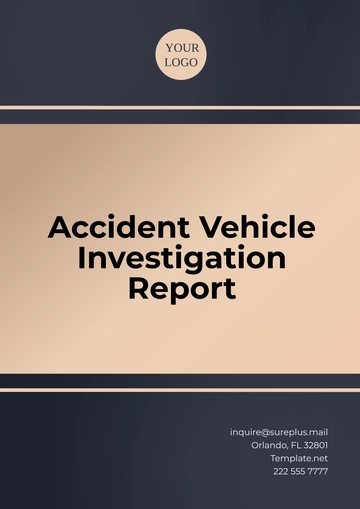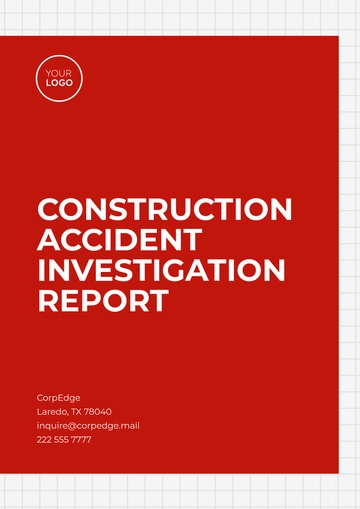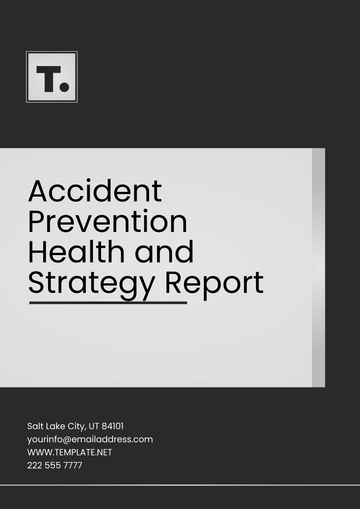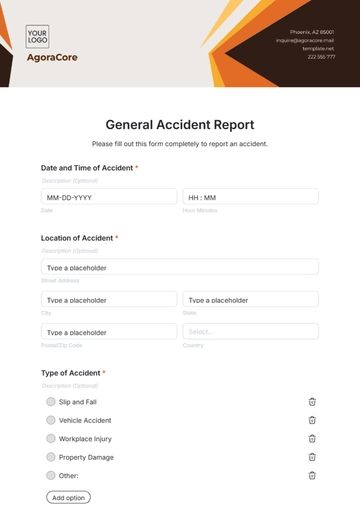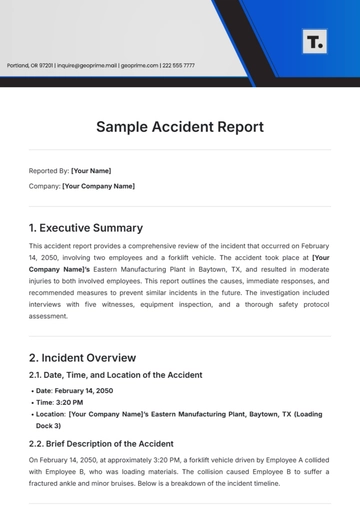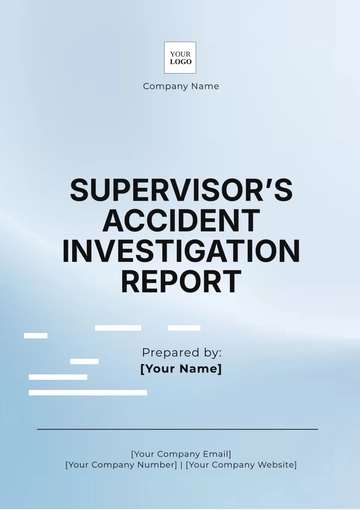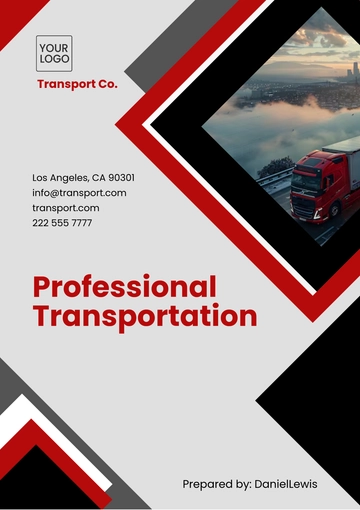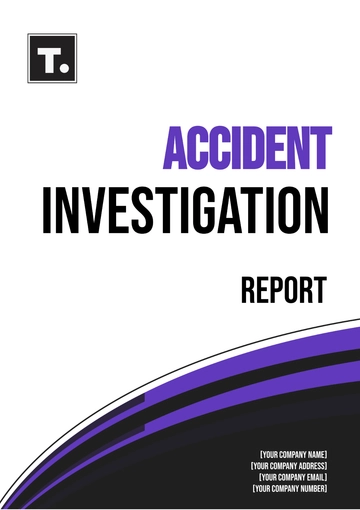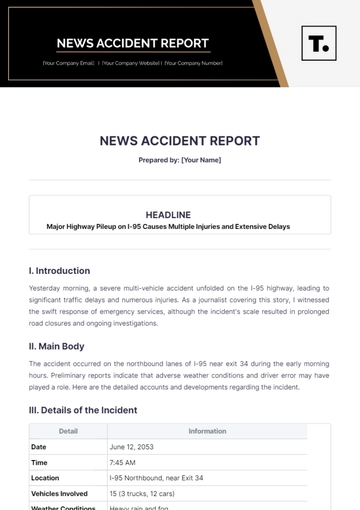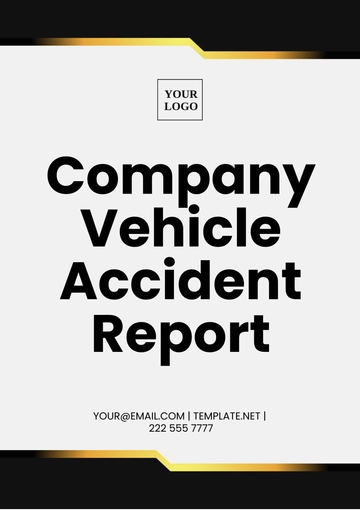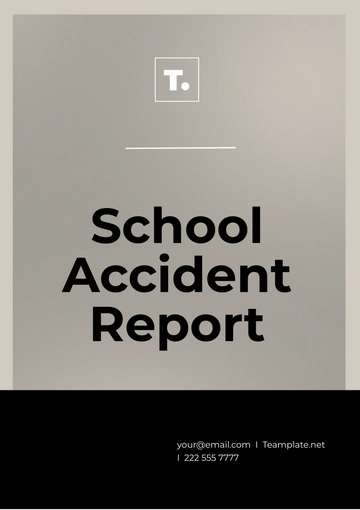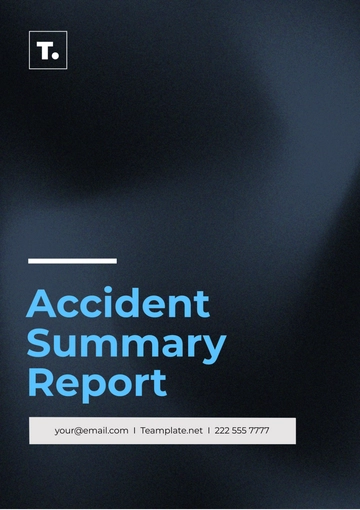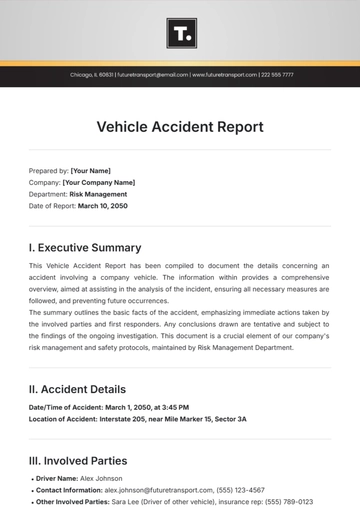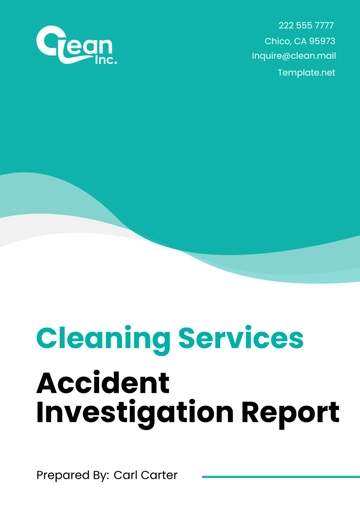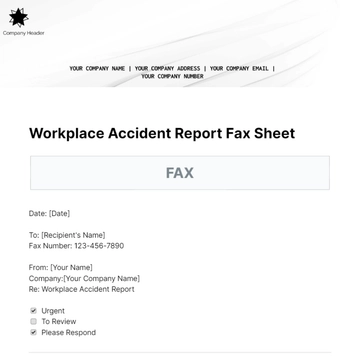Free Cleaning Services Accident Investigation Report
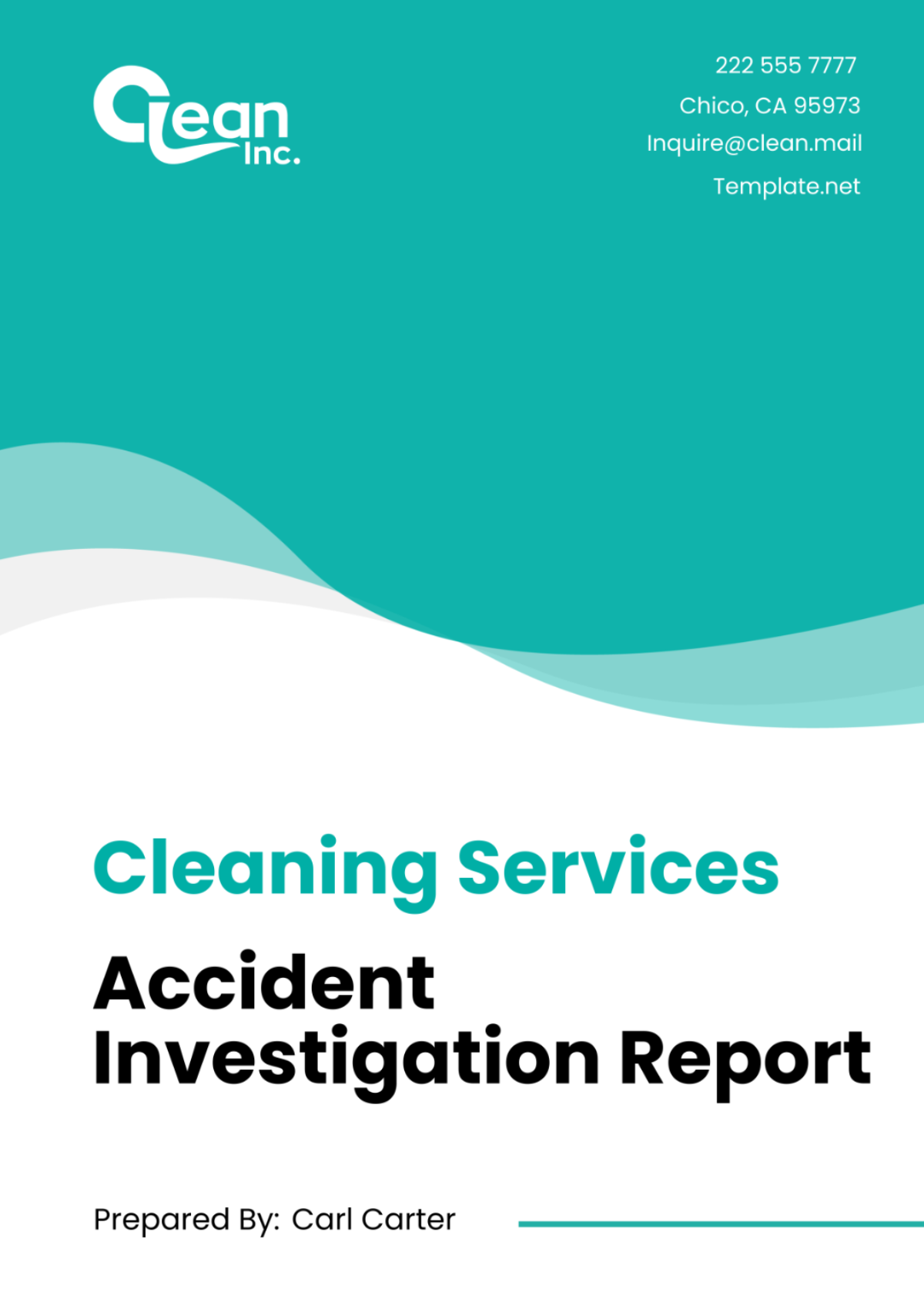
I. Executive Summary
The incident occurred on [Date] at [Your Company Address] during routine cleaning operations. A cleaning staff member, [Name], slipped and fell while mopping the floor in the hallway of the office building, resulting in a fractured wrist and minor head injury. Immediate medical attention was provided, and the staff member is currently recovering. The investigation revealed several contributing factors, including a lack of signage indicating wet floors, inadequate lighting in the hallway, and insufficient non-slip footwear provided to the staff. Recommendations include enhancing floor safety measures, conducting regular safety inspections, and providing appropriate personal protective equipment (PPE) to employees.
II. Incident Details
The incident, which took place in the lobby section of the commercial office complex, involved a member of the cleaning team who is known as [Name]. At the time of the occurrence, she was in the process of mopping the floor. Unfortunately, [Name] experienced a fall due to a slippery surface resulting from the water on the floor. This fall led to an injury to her ankle. It is important to note that no other persons were directly involved or affected by this occurrence.
Responsibilities were promptly acted upon in response to the accident. Actions included summoning immediate first aid assistance for [Name], which specifically targeted the care and treatment necessary for her injured ankle. In addition, it was deemed critical to swiftly apprise those persons who had oversight and control of the building management about the incident.
III. Injury and Damage Assessment
Before starting the investigation, it was fundamental to make an assessment of any injuries sustained and any damage done to property. This specific part of the report covers the immediate medical treatment that was provided to the employee who was injured. Also, it gives a thorough evaluation of the severity of the injuries, as well as the extent of any damages incurred by either property or equipment related to the incident.
Details of the assessment are vital as they help to establish a clearer overview of the incident and guide the construction of measures to prevent such incidents in the future.
Injuries Sustained: |
|
Medical Treatment: |
|
Property Damage: |
|
IV. Factors Contributing to the Incident
It is of great significance to have a comprehensive understanding of the various contributing factors that played a role in leading to the incident. This unambiguous comprehension is integral to pinpointing specific areas which can be improved within the safety protocols, hence making an effective effort towards preventing similar incidents in the future.
This particular section of the report takes an in-depth look at both immediate unsafe acts or conditions that were observed in the course of the accident, and the more hidden, underlying factors that may potentially have played a role in not just facilitating, but even escalating the severity of the incident. It is essential to unravel each layer of contributing factors to fully ascertain the chain of events that led to the incident and subsequently, draft preventive steps to enhance safety protocols.
The investigation identified the following factors contributing to the incident:
Factors | Description |
|---|---|
Wet Surface | Failure to adequately mark or cordon off the wet floor area after mopping. |
Lack of Slip-Resistant | Floor Mats Absence of slip-resistant floor mats in the lobby area. |
Inadequate Lighting | Poor lighting conditions in the lobby area may have contributed to the accident. |
V. Investigation Process
The investigation involved interviews with the injured employee, witnesses, and relevant supervisors. The accident scene was thoroughly examined, and photographs were taken to document the conditions. Safety procedures and training records were reviewed to assess compliance and identify any gaps. Data from previous incident reports and safety inspections were analyzed to identify any recurring issues.
Interviews were conducted with [Name] and witnesses present at the time of the incident.
The accident scene was examined to assess environmental conditions and identify any hazards.
Review of cleaning protocols and safety procedures related to floor maintenance.
VI. Findings and Analysis
The results of the investigation have indicated that the chief cause of the accident primarily lied in a conjunction of negative factors. These factors include the conditions of the floor that were notably slippery, lighting that was not up to par, and the presence of safety measures that proved to be inadequate. Moreover, the situation was made even worse due to the absence of sufficient warning signs that are usually put up to caution individuals of potential hazards and due to the fact that the appropriate footwear, which would have enabled individuals to maintain their balance on the slippery floor, were not being used. This unpreparedness and inadequacy to handle the physically challenging conditions were further intensified and turned into a risk that made individuals considerably more exposed to possibilities of experiencing slips and falls. The investigation reveals that there was an egregious failure in addressing these hazards in the right manner. This should have been accomplished through the provision of appropriate training designed to enable individuals to navigate said challenging conditions, and through the regular execution of safety inspections that are meant to ensure the continued practicality and applicability of all safety measures set in place. These findings highlight, with utmost emphasis, the pressing and immediate need to take corrective actions. These actions should aim to improve the protocols related to safety and thereby prevent any similar incidents from occurring in the future. With the application of enhanced regulations that are capable of mitigating, if not eliminating, the mentioned negative factors, safety can indeed be achieved.
VII. Recommendations
Based on the findings of the investigation, a set of actionable recommendations has been formulated to address the identified deficiencies and prevent similar incidents in the future. These recommendations aim to enhance safety measures, improve training protocols, and establish proactive measures to mitigate risks within the cleaning services environment.
Based on the findings, the following recommendations are proposed to prevent similar incidents in the future:
Implement clear signage indicating wet floors.
Improve lighting in areas prone to low visibility.
Provide non-slip footwear to all cleaning staff.
Conduct regular safety training sessions focusing on hazard awareness and prevention.
Establish a system for routine safety inspections and audits.
Encourage reporting of hazards and near misses to proactively address safety concerns.
VIII. Implementation Plan
To effectively address the recommendations outlined in this report, a detailed implementation plan has been developed. This plan delineates specific actions, timelines, and responsibilities for executing the recommended measures. By following this plan, we aim to swiftly and effectively enhance safety practices and prevent recurrence of similar incidents.
It is crucial that we immediately implement a set of protocols that are specifically designed for marking areas where the floors are wet.
The process of procuring mats that are resistant to slips and their subsequent installation process must be carried out and complete within a timeframe of one week.
Over the course of the next thirty days, our team is planning to carry out a detailed evaluation of the lighting fixtures that are currently installed in the lobby area of our building. Following this evaluation, we will then be proceeding with an upgrade of these fixtures. This upgrade is designed to enhance the quality and efficiency of lighting within the lobby area for both our staff and visitors.
IX. Follow-Up and Monitoring
To secure maximum safety and adherence to the measures put in place, we will commit to conducting follow-up inspections regularly. These inspections aim not only at ensuring that safety regulations and protocols are being adhered to strictly but also at assessing the effectiveness of the solutions that have been implemented. It is through such evaluations that we can gauge how well our set measures work in securing the safety we aim for. In addition to this, we will constantly review incident reports.
This continuous review process will enable us to identify any trends that stand out or issues that regularly reoccur. By spotting these elements, we can take the necessary steps to address them and prevent their recurrence.
Once the evaluation of this incident has been completed and we have gained extensive insights from it, we will effectively relay these findings to the cleaning staff. It is imperative that every member of the cleaning staff partakes in safety meetings and training sessions designed for this purpose. Through these interventions, our staff will have the knowledge and skills to incorporate the learnings from the incident evaluation into their daily work, thereby improving safety standards across the board.
X. Conclusion
Closing this discussion, the report that has been generated as a result of the investigation into the accident has brought to light the crucial importance of giving top priority to safety measures when it comes to operations related to cleaning services. By ensuring that our focus is directed towards addressing the factors that have been identified in this report and putting into effect the actions that are suggested as recommendations, there is potential to lessen the chances of identical incidences occurring in the future.
The main aim behind this is to guarantee the health and safety of our employees and clients. In order to establish a work environment that is safe, it is absolutely crucial to continuously maintain vigilance. We also need to make sure that safety measures are not just implemented when an issue arises, but are instead a regular, proactive part of our operation. Underlying all of this is the critical understanding that it is an ongoing commitment to safety and vigilance that makes the key difference in maintaining the safety of a working environment.
- 100% Customizable, free editor
- Access 1 Million+ Templates, photo’s & graphics
- Download or share as a template
- Click and replace photos, graphics, text, backgrounds
- Resize, crop, AI write & more
- Access advanced editor
Discover the comprehensive Cleaning Services Accident Investigation Report Template on Template.net. This editable and customizable template streamlines incident documentation with its user-friendly interface. Seamlessly tailor the report to your organization's needs using the AI Editor Tool. Enhance safety practices effortlessly with this essential tool for analyzing, reporting, and preventing accidents in cleaning services.
You may also like
- Sales Report
- Daily Report
- Project Report
- Business Report
- Weekly Report
- Incident Report
- Annual Report
- Report Layout
- Report Design
- Progress Report
- Marketing Report
- Company Report
- Monthly Report
- Audit Report
- Status Report
- School Report
- Reports Hr
- Management Report
- Project Status Report
- Handover Report
- Health And Safety Report
- Restaurant Report
- Construction Report
- Research Report
- Evaluation Report
- Investigation Report
- Employee Report
- Advertising Report
- Weekly Status Report
- Project Management Report
- Finance Report
- Service Report
- Technical Report
- Meeting Report
- Quarterly Report
- Inspection Report
- Medical Report
- Test Report
- Summary Report
- Inventory Report
- Valuation Report
- Operations Report
- Payroll Report
- Training Report
- Job Report
- Case Report
- Performance Report
- Board Report
- Internal Audit Report
- Student Report
- Monthly Management Report
- Small Business Report
- Accident Report
- Call Center Report
- Activity Report
- IT and Software Report
- Internship Report
- Visit Report
- Product Report
- Book Report
- Property Report
- Recruitment Report
- University Report
- Event Report
- SEO Report
- Conference Report
- Narrative Report
- Nursing Home Report
- Preschool Report
- Call Report
- Customer Report
- Employee Incident Report
- Accomplishment Report
- Social Media Report
- Work From Home Report
- Security Report
- Damage Report
- Quality Report
- Internal Report
- Nurse Report
- Real Estate Report
- Hotel Report
- Equipment Report
- Credit Report
- Field Report
- Non Profit Report
- Maintenance Report
- News Report
- Survey Report
- Executive Report
- Law Firm Report
- Advertising Agency Report
- Interior Design Report
- Travel Agency Report
- Stock Report
- Salon Report
- Bug Report
- Workplace Report
- Action Report
- Investor Report
- Cleaning Services Report
- Consulting Report
- Freelancer Report
- Site Visit Report
- Trip Report
- Classroom Observation Report
- Vehicle Report
- Final Report
- Software Report
